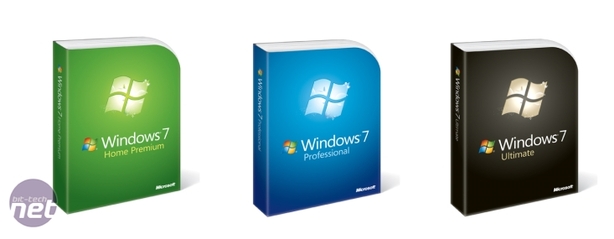
Microsoft Windows 7 Review
Manufacturer: MicrosoftUK Pricing (Full Version):
- Home Premium: £114.98 (inc VAT)
- Professional: £148.00 (inc VAT)
- Ultimate: £169.97 (inc VAT)
US Pricing (Full Version):
- Home Premium: $199.99 (ex Tax)
- Professional: $299.99 (ex Tax)
- Ultimate: $319.99 (ex Tax)
Ever since Microsoft released the first and only Windows 7 beta, there’s been a lot of hype around the new operating system - we had an early look at Windows 7 shortly after the beta came out back in January and came away impressed. The development schedule has been incredibly smooth, running almost perfectly and hitting key milestones with accuracy normally only associated with Swiss watchmakers.
This was in stark contrast to Vista’s long road to release, which saw delays, feature culling and a final product that wasn’t everything it should have been. Combine that with the horrible driver support from many manufacturers (and especially Nvidia from a gamer's point of view) and you have a recipe for disaster. Not surprisingly, most PC users stuck with their old friend Windows XP. Microsoft recognised this, and it looks as if it has listened to consumers’ major bugbears with Vista. For want of a better way of describing it, Microsoft has essentially fixed Vista and the result is arguably Microsoft’s best operating system to date.

Vista’s problems started long before you even got around to installing the OS though - the mess of versions really didn't help consumers make the choice that best suited their needs (or maybe it did, by keeping them away from Vista? - Ed.). Microsoft had gone from the simple three-tiered approach adapted for Windows XP - Home, MCE and Professional - to no fewer than five versions of Vista, and a confusing choice of four in the shops. Worse still, some versions lacked features that were present in cheaper versions, making people think the whole version scheme was a sneaky ploy to make people buy the exorbitant Ultimate Edition.
Windows 7 takes a step back from Vista’s craziness, with just three main versions – Home Premium, Professional and Ultimate – with clearly defined feature sets. Microsoft has a great breakdown of what each of the three versions includes on its website and we've simplified this in the table below.
Windows 7 Home Premium establishes a baseline feature set, with the pricier versions adding more features. Crucially, no features are removed as you move up the price scale as they were on Vista, so every version of Windows 7 includes Media Center, for example. Microsoft includes both 32-bit and 64-bit editions of each version in the full retail box, but we’d recommend skipping the 32-bit version if your CPU supports x86-64 extensions, as it enables you to address more memory and register space, which can result in better application performance.
Pretty much every recent desktop CPU since the original Athlon 64 supports 64-bit, although some Atom and similar low-power CPUs don’t. Many applications have 64-bit executables to deliver extra performance, but Windows 7 supports both 32-bit and 64-bit applications, so you shouldn’t see incompatibility problems. For example, Photoshop Elements 7 doesn’t have a native 64-bit executable, yet it still runs flawlessly on 64-bit Windows 7.

Windows 7 version comparison
A fourth edition, Windows 7 Starter, won’t be sold in shops and will only be pre-installed on netbooks. This naturally doesn't follow the same feature set as the fully fledged versions of Windows 7 - but it doesn't need to, frankly. The number of applications running concurrently has been limited to three, Aero mode has been removed and so has Media Center - these are hardly likely to cause problems a netbook, but we will be looking at running a full version of Windows 7 on a netbook very soon.
Home Premium is the best choice for most people, but there are reasons to look beyond it, even if you’re not running a business. For example, even the 64-bit version of Home Premium is limited to addressing a maximum of 16GB of system memory, and it can only be used on single-socket systems. If you’re running a dual-processor workstation, you’ll need Professional or Ultimate.
Professional and Ultimate also include Windows XP Mode, which runs a fully fledged version of Windows XP Service Pack 3 in a virtual machine. This is a great addition for businesses who are concerned that their applications won't run natively in Windows 7 because it enables them to run in a familiar environment. However, there is one more provision that you need to consider on top of buying a more expensive version of Windows 7 - you will need a CPU with built-in virtualisation support, otherwise the virtual machine will not start.
Microsoft has made it easy to upgrade from one version of Windows 7 to the next – you can use Microsoft’s Windows Anytime Upgrade (WAU) system to upgrade on the fly. Admittedly, WAU pricing isn’t as attractive as buying the right edition in the first place – the upgrade from Home Premium to Professional costs £120. Add that to the £65 or so that you paid for Windows 7 Home Premium in the first place, and you pay almost 25 per cent more than if you’d chosen the right version first time around.

MSI MPG Velox 100R Chassis Review
October 14 2021 | 15:04









Want to comment? Please log in.